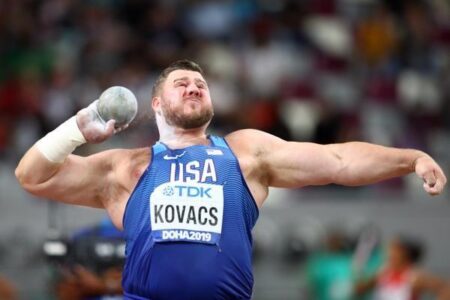A groundbreaking study published in Nature sheds new light on how purine metabolism varies between sprint- and endurance-trained athletes across the adult lifespan, from 20 to 90 years old. This research offers unprecedented insights into the biochemical pathways that underpin athletic performance and recovery, revealing age-related shifts that could influence training and health strategies for athletes of all ages. As scientists unravel the metabolic distinctions tied to different exercise modalities and decades of life, these findings promise to enhance our understanding of muscle function, energy utilization, and the aging process in the world of sport.
Purine Metabolism Differences Between Sprint and Endurance Athletes Uncovered
Recent investigations into metabolic pathways have shed light on how purine metabolism distinctly adapts between sprint and endurance athletes across a broad age spectrum. Sprint-trained individuals exhibit a heightened capacity for rapid purine catabolism, facilitating the swift energy turnover necessary for explosive bursts of activity. In contrast, endurance athletes demonstrate an enhanced purine salvage pathway efficiency, which supports prolonged ATP regeneration during extended exertion periods. These metabolic nuances underscore the tailored biochemical demands imposed by different exercise modalities.
A comparative analysis revealed key biochemical markers differing significantly between the two groups:
- Elevated hypoxanthine levels in sprinters post-exercise, indicating rapid ATP breakdown.
- Increased IMP recycling in endurance athletes, promoting ATP sustainability.
- Age-related variations suggest that purine metabolism remains remarkably adaptable well into older adulthood, especially in well-trained individuals.
| Metabolic Feature | Sprint Athletes | Endurance Athletes |
|---|---|---|
| Hypoxanthine Post-Exercise | High ↑ | Moderate ↔ |
| IMP Recycling Rate | Low ↓ | High ↑ |
| Adaptation with Age | Stable | Enhanced |
Age-Related Metabolic Shifts Impact Athletic Performance Across Decades
Throughout the human lifespan, metabolic processes undergo significant transformations that deeply influence physical capabilities. In particular, the balance of purine metabolism-a key player in energy production and recovery-shifts distinctly between sprint- and endurance-trained athletes as they age. Sprint athletes, who rely on explosive bursts of power, tend to exhibit a more pronounced decline in purine recycling efficiency after the fourth decade, impacting their rapid energy turnover and muscular recovery. Conversely, endurance athletes maintain a steadier purine metabolism profile well into their sixties, correlating with sustained aerobic capacity and prolonged performance longevity.
Such age-related metabolic variations are further underscored by the differing patterns of nucleotide degradation and synthesis observed across disciplines. The following table summarizes the comparative trends in purine metabolites detected in plasma samples from athletes aged 20 to 90 years, highlighting how training modality and age intertwine to shape biochemical resilience:
| Age Group | Sprint Athletes (Purine Turnover Rate) | Endurance Athletes (Purine Turnover Rate) |
|---|---|---|
| 20-35 | High | Moderate |
| 36-50 | Moderate ↓ | Stable |
| 51-70 | Low ↓↓ | Moderate ↓ |
| 71-90 | Minimal ↓↓↓ | Low ↓↓ |
- Purine turnover declines sharply in sprint-trained athletes post-50s, limiting rapid energy availability.
- Endurance athletes display a gradual decline, supporting sustained energy efficiency over decades.
- Metabolic adaptability may be key to prolonging athletic longevity regardless of sport type.
Tailored Nutrition and Training Strategies Recommended Based on Metabolic Profiles
Recent investigations into purine metabolism have shed light on how metabolic profiles distinctly influence dietary and training prescriptions for athletes specializing in sprint versus endurance disciplines. Sprint-trained athletes exhibit elevated concentrations of purine metabolites related to rapid energy turnover, suggesting a need for nutrition that supports intense anaerobic bursts and rapid recovery. Conversely, endurance-trained athletes display metabolic adaptations conducive to sustained aerobic activity, highlighting the importance of strategies that optimize mitochondrial efficiency and prolonged energy availability.
Customized recommendations based on these findings emphasize:
- For sprint athletes: increased intake of antioxidants and phosphate donors to buffer against rapid ATP degradation.
- For endurance athletes: prioritization of complex carbohydrates and micronutrients that support oxidative phosphorylation.
- Training regimens calibrated to metabolic demands-interval training for sprinters versus steady-state efforts for endurance athletes.
| Metabolic Feature | Sprint Athletes | Endurance Athletes |
|---|---|---|
| Purine Metabolite Levels | High | Moderate |
| ATP Turnover Rate | Rapid | Steady |
| Recommended Nutritional Focus | Phosphate & antioxidants | Carbohydrates & micronutrients |
Future Outlook
As this comprehensive study highlights, the intricate dynamics of purine metabolism differ markedly between sprint- and endurance-trained athletes across a broad age spectrum. These findings deepen our understanding of how training modalities uniquely influence biochemical pathways, potentially informing personalized approaches to athletic performance and recovery. As research continues to unravel the complexities of metabolism in aging populations, this work sets a foundation for optimizing health and performance from early adulthood well into later years. The intersection of exercise science and metabolic biology remains a promising frontier, with implications extending far beyond the track.





